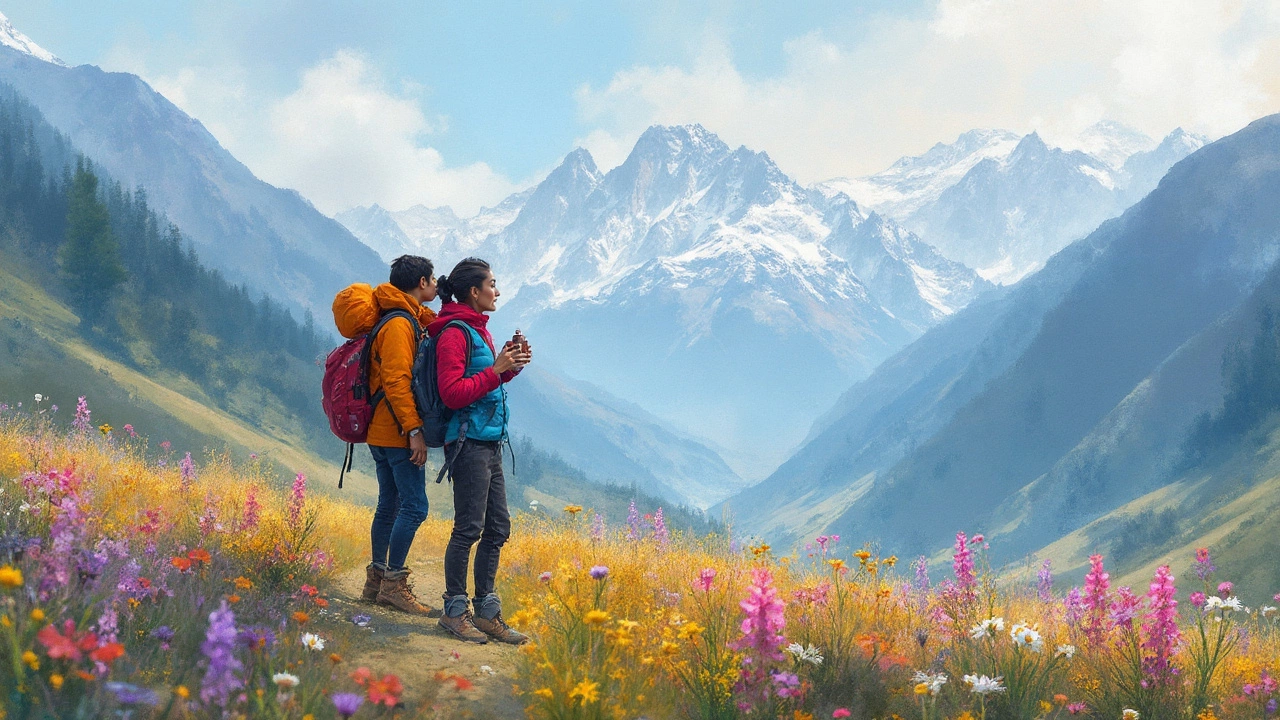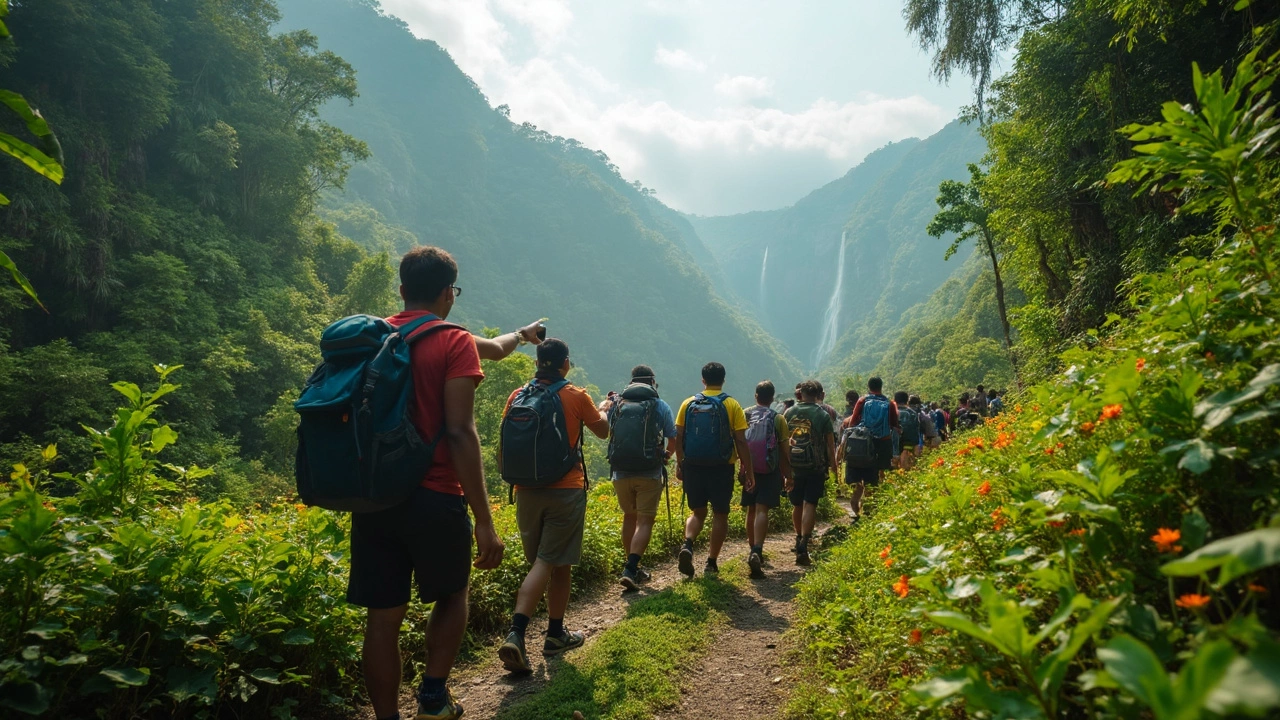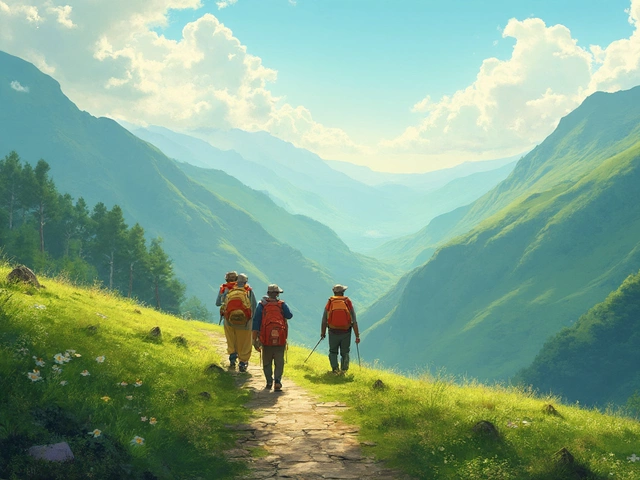Turns out, if you ask a random traveler in India about hiking, chances are they’ll mention a place in the Himalayas or Western Ghats. No surprise—these regions lure everyone, from casual backpackers to fitness junkies itching for a real challenge. The funny part? A handful of trails grab all the attention, no matter how many hidden gems pop up on Instagram each month.
For anyone with a decent pair of shoes and a bit of wanderlust, the big-name hikes are both accessible and memorable. These popular routes usually have better infrastructure, guides, and even WiFi signals (if you’re desperate). People aren’t just drawn in by the views—think cozy homestays, platefuls of steaming maggi, and a chance to meet other travelers from all over.
If you’re curious where everybody is actually walking, not just snapping photos, keep reading. You’ll find the Himalayan classics, southern green loops, and advice to avoid rookie mistakes like underestimating altitude or missing permits. Let’s dig into what crowds are chasing—and why those trails are worth the hype.
- Most Popular Tourist Hiking Trails
- Himalayas: The Classic Magnet
- Western Ghats: The Lush Escape
- Hidden Trails Gaining Fame
- What to Expect on the Trail
- Tips for Trekkers
Most Popular Tourist Hiking Trails
Let’s be honest, most travelers hunting for trekking places make a beeline for a handful of famous trails—they’re busy for good reason. These routes tick all the boxes: amazing views, doable for most fitness levels, and a system that supports hikers from start to finish. If you’re planning your first trip or want to know where the crowd is headed, here’s where the action is.
- Kedarkantha Trek: This one in Uttarakhand is a classic, especially in winter. With snow underfoot and sunrise views that light up the whole sky, it’s become the go-to trekking India experience. Most folks finish in 4-5 days, and it’s beginner-friendly.
- Triund Trek: Super popular with anyone starting out, Triund near McLeod Ganj is a quick escape with views of the Dhauladhar range. Half a day up, picnic on top, and back down by sundown if you want.
- Valley of Flowers: Famous for good reason—every summer, the whole valley explodes with color. The hike isn’t too tough and there’s a high chance you’ll see folks of all ages on this route. It’s a UNESCO World Heritage Site, too.
- Hampta Pass: If you want something dramatic but still manageable, Hampta gives you snowy passes, river crossings, and a blend of lush green and barren mountain landscapes. It runs between June and September.
- Rajmachi Trek: Further down south in Maharashtra, this is a classic monsoon trek that’s all about mist, waterfalls, and old forts. It’s especially crowded during the rainy season, and locals turn it into a weekend picnic spot.
Here’s a quick look at how popular these hikes get. During peak times, hundreds start these trails every day. Check out this table for a sense of scale:
| Trail | Average Hikers/Day (Peak Season) | Best Months |
|---|---|---|
| Kedarkantha | 250+ | December - April |
| Triund | 200+ | March - June, Sept - Nov |
| Valley of Flowers | 150+ | July - September |
| Hampta Pass | 120+ | June - September |
| Rajmachi | 400+ | June - September |
Notice how the numbers jump when school holidays or long weekends hit. Almost every hiker you chat with has done at least one of these. If you want creature comforts, homestays and tea stalls are easy to find on these trails—just bring some cash and a smile.
Quick tip: Book permits or local stays before you go, especially in peak season. Getting stuck without a tent or room is more common than you’d think. Most trails have plenty of resources online, but ask recent trekkers for the latest details on conditions, closures, and what’s actually open at the base village.
Himalayas: The Classic Magnet
When most folks dream about hitting the big trekking spots in India, their mind jumps straight to the Himalayas. This mountain range stretches across five states—Jammu & Kashmir, Himachal Pradesh, Uttarakhand, Sikkim, and Arunachal Pradesh—so you have no shortage of options. What makes these trails a trekking India hotspot is a mix of mind-blowing scenery, buzzing trail culture, and hikes for just about every skill level.
The Kedarkantha trek, with its reliable snow and panoramic peaks, is a top pick. It’s doable for beginners but still feels epic. Chadar Trek in Ladakh draws hardcore adventurers every winter, mainly because you literally hike over the frozen Zanskar river. Valley of Flowers, a UNESCO World Heritage Site, puts up a wild show of colors every July and August. It’s an easy-moderate trek, but the views and rare Himalayan blooms keep tourists coming back.
Other super popular Himalayan treks:
- Roopkund Trek (Uttarakhand): Famous for its high-altitude mysterious skeleton lake (yes, human bones at 16,000 feet!).
- Hampta Pass (Himachal Pradesh): Loved for its crazy landscape switch from green valleys to barren Spiti desert in five days.
- Triund Trek (Himachal Pradesh): Quick and easy, just above McLeod Ganj, with insane views of the Dhauladhar range. Great for weekends.
- Goechala Trek (Sikkim): Hardcore, but if you want to stare at the face of Mt. Kanchenjunga, this is the one.
So, what’s the real attraction? Himalayan treks are packed with marked trails, cozy base camps, and local guides who know their stuff. If you’re worried about crowds, steer clear during the summer vacation months or major holidays.
Check out how popular some of these trails have become:
| Trek Name | Best Season | Annual Tourist Footfall (est.) |
|---|---|---|
| Kedarkantha | Dec–April | 18,000+ |
| Valley of Flowers | July–Aug | 15,000+ |
| Hampta Pass | June–Sept | 10,000+ |
| Triund | Mar–June, Sept–Nov | 20,000+ |
If you’re a first-timer, grab a spot on a guided trek. Bring layers, basic meds, and plan for at least two extra days if you’re heading to high altitudes. Temperatures swing wildly—sunny one minute, snow the next. No concrete paths, just raw, wild nature and a camera roll full of bragging rights.
Western Ghats: The Lush Escape
If steep Himalayan climbs sound like too much too soon, the trekking India crowd often heads for the Western Ghats. This 1,600 km mountain range, running down India’s west coast through Maharashtra, Goa, Karnataka, Kerala, and Tamil Nadu, is a serious trekking hotspot. Not just for the jaw-dropping greenery, but for the mix of chill shorter trails and some real leg-day level hikes.
One of the biggest crowd pullers is Karnataka’s Kudremukh trek. It winds you past cloud forests, wild streams, and the famous "horse face" peak. In Kerala, Chembra Peak is a favorite for its heart-shaped lake and relatively short route—perfect for a weekend trip. Maharashtra’s Rajmachi trek gets packed during monsoon with its dramatic forts, waterfalls, and lush valleys. And in Tamil Nadu, the Meesapulimala trek gives a real escape from city crowds, often above the clouds themselves.
Here’s a quick peek at how some popular Western Ghats treks stack up:
| Trek Name | State | Length (km) | Best Season |
|---|---|---|---|
| Kudremukh | Karnataka | 20 | June – Feb |
| Rajmachi | Maharashtra | 16 | June – Sep |
| Chembra Peak | Kerala | 7 | Sep – Feb |
| Meesapulimala | Tamil Nadu | 18 | Nov – Feb |
One cool thing about hiking here: you don’t need pro gear. But you will want solid shoes—these trails get crazy slippery in the rains. The Western Ghats stay green most of the year, but monsoon rocks the views (and the leech situation). If you’re after animal sightings, including bison, elephants, or maybe even leopards, sunrise or sunset is your moment.
- Permits are mostly a thing on the more famous hills—check online before you pack.
- Local guides help, especially in spots where signage is a joke or leeches are real.
- Trekking during off-peak months means fewer crowds but sometimes less support (shops and homestays may be closed).
If you want your hike to be less about showing off on Instagram and more about real wilderness, the Western Ghats deliver. Just go prepared for the weather and remember, the early morning fog and endless green make the sweat totally worth it.

Hidden Trails Gaining Fame
If you’ve done the main treks and want something fresher, there’s a wave of hidden trails stealing the spotlight. These weren’t always on bucket lists, but lately, groups and solo travelers are heading out for routes less crowded and way more chilled out. A lot of these spots give you wild landscapes and wildlife encounters, minus the tourist crush.
Let’s break down a few trails picking up steam in 2025:
- Tarsar Marsar Lake Trek, Kashmir: You get two alpine lakes, grassy meadows, and hardly any crowds outside the short summer window. Most hikers still focus on Kashmir Great Lakes, but word’s getting out—maybe because tent camping by the lake here feels like a private movie set.
- Pindari Glacier, Uttarakhand: The path isn’t tough, and it’s perfect for people new to trekking. Spots like Khati village are super welcoming, and locals often host small trekkers’ huts. Not as dramatic as Everest, but the glacier views are epic for the effort.
- Kumara Parvatha, Karnataka: Down south, this peak is a favorite for college groups and weekend warriors. The climb is steep, the forest is thick, and the sunrise view over the Western Ghats is ridiculous. Stay sharp—leeches love this spot during monsoons!
- Bara Bhangal, Himachal Pradesh: Definitely for tough hikers, but the isolation means you’ll only see serious trekkers and shepherds. The trail links two valleys—Kullu and Kangra—crossing wild rivers and remote passes.
For those who want the highlights at a glance, check this table with stats from last year’s trekking permits (as published by regional forest officials):
| Trail | Average Duration (Days) | Permit Issued (2024) | Main Season |
|---|---|---|---|
| Tarsar Marsar | 7 | 1,400 | July-Sept |
| Pindari Glacier | 5 | 2,050 | April-June |
| Kumara Parvatha | 2 | 3,100 | Oct-Feb |
| Bara Bhangal | 12 | 580 | June-Oct |
One big pro with these emerging routes is genuine flexibility. You can often walk in, grab local guides right in the base villages, and get real homemade food (not just instant noodles). But before heading to these offbeat spots, check current permit rules and camp responsibly—local communities are still figuring out where mass tourism fits in.
Looking for ‘hidden’ doesn’t mean risky, though. Ask around, talk to people in the last village before your trail starts, and stay connected with someone back home. The rise of these trekking India routes shows hikers want variety, not just crowds and selfie spots.
What to Expect on the Trail
If you’re hitting India’s top trekking routes, be ready for a mix of excitement, challenge, and the odd headache. The trails attracting the most tourists, like Kedarkantha and Triund, are marked clearly and often packed—sometimes it feels like a moving village, especially on weekends. You’ll bump into snack stalls, chai tents, and herds of fellow hikers. But that doesn’t mean it’s always a stroll in the park.
Weather is a big wildcard. Himalayan hikes can shift from sunny to hailstorm in one afternoon. In summer, you might deal with blazing sun, while spring and autumn bring chilly winds and cold nights. Monsoon treks, especially in the Western Ghats, are muddy and alive with leeches. Watch your step, literally.
Altitude catches people off guard most often. Climbing quickly to spots above 3,000 meters—like at Roopkund or Hampta Pass—can leave you dizzy or gasping. Plan for slower pace and lots of hydration, and don’t shrug off headaches or nausea.
- trekking India routes are rarely empty—weekends and holidays bring crowds. Book stays ahead and expect busy camps.
- Many popular trails have basic toilets and campsites, but don’t expect luxury. You’ll carry your own trash out (and yes, that means used tissues).
- Wildlife isn’t just a rumor: On some trails, trekkers spot langurs, mountain goats, and sometimes even bears (so stash food well).
- Connectivity is dicey above 2,500 meters. Let someone know your plan before you get off-grid.
- Permits are often mandatory. In places like Valley of Flowers and Sandakphu, guards do check paperwork.
Most folks are surprised by how social these treks can get. People swap stories over bonfires, share trail food, and sometimes even finish with new friends for life. Basically, you’re signing up for more than scenery—you’re jumping into a mini community that resets every morning with the sunrise.
Tips for Trekkers
Let’s not sugarcoat it—Indian trekking comes with its own quirks. Forgetting the basics can turn an awesome trip into a headache, so here’s what you really need to know before lacing up your boots for any of the trekking India favorites.
- Prep for Weather Mood Swings: Trails like Kedarkantha or Roopkund can go from sunny to freezing in hours. Always pack a rain jacket and at least one thermal layer—even in what locals call “summer.”
- Don’t Ignore Acclimatization: If your trek goes above 3,000 meters (most popular Himalayan ones do), give yourself a buffer day to adjust. Skipping this is a fast track to altitude sickness.
- Permits Aren’t Optional: Treks like Valley of Flowers or Hampta Pass require government permits. Double-check online, because these rules change every season—and fines for missing paperwork are stiff.
- Stay Plastic-Free: Parks in Sikkim, Uttarakhand, and Himachal are strict. Carry reusable bottles and snack containers, or get ready for checks at entry points.
- Carry Cash, Not Just Cards: ATMs vanish once you leave big towns. Most base villages only take cash for food, guides, or even emergency ponchos.
- Know Your Network Gaps: Except in some base camps, your phone is basically a brick. Tell your folks you’ll be out of touch for a bit, and note any available emergency contacts posted at trailheads.
- Book Accommodation Early: Places like Triund and Tosh fill up way in advance, especially on long weekends or during summer break. Avoid being stranded by reserving your homestay or guesthouse ahead of time.
Need a quick look at what gear is actually useful? Here’s how most trekkers keep it simple and safe:
| Gear | Why it Matters |
|---|---|
| Waterproof hiking shoes | Monsoon season turns trails into mud baths. Dry feet = happy feet. |
| Quick-dry clothes | Heavy cotton stays wet, gives you chills. Synthetic or merino works best. |
| Power bank | No charging points after the first day, especially in the mountains. |
| Basic first-aid kit | Band-aids, painkillers, antiseptic cream. Local clinics are rare up high. |
| Reusable water bottle | Saves cash and the environment—tap-water refill stations are common now. |
| Snacks (nuts, energy bars) | Great for sudden bursts of hunger between meal stops or at the summit. |
Last thing: listen to local guides, not just random blogs. They know about new trail closures, wild animal sightings, and weather warnings way before the rest of the world. Trusting them can literally save your trip—or your life.


